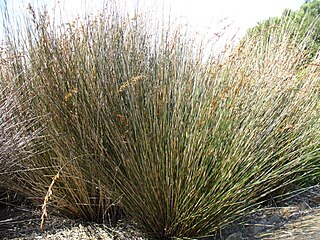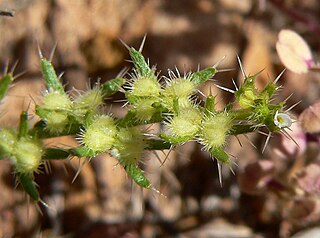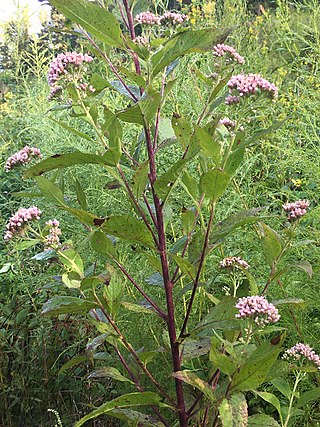
Pulmonaria (lungwort) is a genus of flowering plants in the family Boraginaceae, native to Europe and western Asia, with one species east to central Asia. According to various estimates there may be between 10 and 18 species found in the wild.

Sherardia is a monotypic genus of flowering plants in the family Rubiaceae. The genus contains only one species, Sherardia arvensis, the (blue) field madder, which is widespread across most of Europe and northern Africa as well as southwest and central Asia and Macaronesia. It is also reportedly naturalized in Australia, New Zealand, Taiwan, Kerguelen, Ethiopia, Sudan, southern Africa, Mexico, Costa Rica, South America, Bermuda, Cuba, Haiti and much of Canada and the United States.

Lithospermum is a genus of plants belonging to the family Boraginaceae. The genus is distributed nearly worldwide, but most are native to the Americas and the center of diversity is in the southwestern United States and Mexico. Species are known generally as gromwells or stoneseeds.

Paliurus is a genus of flowering plants in the family Rhamnaceae. The eight species are native to warm, dry regions of Eurasia and North Africa from Morocco and Spain east to Japan and Taiwan.

Anchusa arvensis is a plant species of the genus Anchusa. Its common names include small bugloss and annual bugloss.

Plagiobothrys is a genus of flowering plants known commonly as popcorn flowers. These are small herbaceous plants which bear tiny white or yellow flowers. Their fruits are nutlets. Although these plants are found predominantly in North America and South America, five species are known from Australia. Of the approximately 65 species described, more than 15 are endemic to California.

Harpagonella is a genus of flowering plants in the borage family. They are known as the grappling-hooks, because of the appearance and function of their fruits. The strange fruits are two small nutlets enclosed in a burlike calyx, which is armed with numerous spines covered in minute, hooked barbs. These diminutive, annual plants are found in sandy, clayey, and gravelly soils, and have small white flowers. This genus is native to North America, and is found in southern California, southern Arizona, northern Sonora, and the Baja California peninsula.

Thamnochortus insignis is a species of grass-like restio of the family Restionaceae, endemic to Cape Province in South Africa.

Lilaea is a monotypic genus of aquatic plants containing the single species Lilaea scilloides, which is known by the common names flowering quillwort, awl-leaf lilaea, and simply lilaea. The taxonomy of this plant has been in debate, with some authors assigning it to a family of its own named Lilaeaceae, and others keeping it in the small arrowgrass family, Juncaginaceae. It is native throughout the Americas and it can be found elsewhere as an introduced species, particularly in Australia. This is an annual herb growing in or just next to water in several types of shallow aquatic habitat, including vernal pools, mudflats, and ditches. The plant takes the form of a tuft of basal leaves around a very short stem. Each onionlike leaf is very narrow, long and pointed, reaching 25 to 40 centimeters long. It is wrapped in a translucent sheath at the base. The inflorescences include clusters of staminate and bisexual flowers at the tip of a narrow stalk as well as pistillate flowers in underwater axils. The pistillate flower is composed of a threadlike style which may be up to 20 centimeters long tipped with a stigma which floats on the water surface. The fruit is a beaked, ribbed nutlet up to a centimeter long.

Oxystylis is a monotypic genus of flowering plants currently considered a part of the cleome family containing the single species Oxystylis lutea, which is known by the common name spiny caper. It is native to the Mojave Desert straddling the border between California and Nevada. It grows in rocky and sandy desert habitat, often on alkaline soils. This is an annual herb producing an erect, branching stem which may reach 1.5 meters in height. The leaf is made up of three thick, firm leaflets 2 to 6 centimeters long, borne on a stout, straight petiole. The inflorescence is a dense head of flowers clustered about the stem at the leaf axils, each flower with four small yellow petals. The fruit is a small white or purple nutlet bearing the spine-like remnant of the flower receptacle.
Pectocarya heterocarpa is a species of flowering plant in the borage family known by the common names chuckwalla combseed and mixed-nut pectocarya. It is native to the southwestern United States and northern Mexico, where it grows in desert, mountain and plateau habitat, in scrub, woodland, and open areas. This is an annual herb producing a slender, rough-haired stem prostrate or upright to a maximum length of about 25 centimeters. The small, pointed linear leaves are alternately arranged, widely spaced along the stem. The inflorescence is a series of flowers, each on a curved pedicel. The flower has small green sepals and tiny white petals. The fruit is an array of four nutlets each lined with comblike prickles.

Pectocarya penicillata is a species of flowering plant in the borage family known by the common names sleeping combseed, shortleaf combseed, winged combseed and northern pectocarya. It is native to much of western North America from British Columbia to Wyoming to Baja California, where it grows in many types of habitat, including disturbed areas such as roadsides. This is an annual herb producing a slender, rough-haired stem, mostly decumbent in form, to a maximum length of about 25 centimeters. The small, pointed linear leaves are alternately arranged, widely spaced along the stem. The inflorescence is a series of flowers, each on a curved pedicel. The flower has small green sepals and tiny white petals. The fruit is an array of four nutlets each lined with comblike prickles.
Pectocarya peninsularis is a species of flowering plant in the borage family known by the common names Baja pectocarya and peninsular pectocarya. It is native to the Sonoran Desert of California and Baja California, where it grows in open desert habitat, including disturbed areas. This is an annual herb producing a slender, rough-haired stem, decumbent or upright form to a maximum length of about 24 centimeters. The small, pointed linear leaves are alternately arranged, widely spaced along the stem. The inflorescence is a series of flowers, each on a curved pedicel. The flower has small green sepals and tiny white petals. The fruit is an array of four nutlets each lined with comblike prickles, those higher on the plant arranged in pairs and the lower ones unpaired.

Pectocarya platycarpa is a species of flowering plant in the borage family known by the common names broadfruit combseed and wide-toothed pectocarya. It is native to the southwestern United States and northwestern Mexico, where it grows in many types of coastal and inland habitat, from mountains to desert. This is an annual herb producing a slender, rough-haired stem, generally upright to erect in form to a maximum height of 25 centimeters. The small, pointed linear leaves are alternately arranged, widely spaced along the stem. The inflorescence is a series of flowers, each on a curved pedicel. The flower has small green sepals and a tiny white corolla. The fruit is an array of four flattened, slightly curving nutlets lined with thin teeth.

Pectocarya pusilla is a species of flowering plant in the borage family known by the common names little combseed and little pectocarya. It is native to the west coast of the United States from Washington to central California, where it grows in several habitat types, including disturbed areas such as roadsides. This is an annual herb producing a slender, rough-haired stem, generally upright to erect in form to a maximum height of about 38 centimeters. The small, pointed linear leaves are alternately arranged higher on the stem, and those lower on the stem are oppositely arranged and fused at the bases. The inflorescence is a series of flowers, each on a curved pedicel. The flower has small green sepals with short hooked hairs and a rounded white corolla. The fruit is an array of four flattened nutlets with fringes of comblike hairs.

Pectocarya recurvata is a species of flowering plant in the borage family known by the common names curvenut combseed and arched-nut pectocarya. It is native to the southwestern United States and northwestern Mexico, where it grows in many types of desert habitat. It is an annual herb producing a slender, rough-haired stem, generally upright to erect in form to a maximum height of about 21 centimeters. The small, pointed linear leaves alternately arranged along the stem. The inflorescence is a series of flowers, each on a curved pedicel. The flower has small green sepals and a rounded white corolla. The fruits, borne in groups of four, are curved nutlets fringed with flat teeth, each measuring 2.5 to 4 millimeters long.

Pectocarya setosa, known by the common names moth combseed and round-nut pectocarya, is a species of flowering plant in the borage family.
Mimophytum is a genus of flowering plants in the family Boraginaceae. The species occur in Northeastern Mexico and adjacent areas of Texas, United States. They are similar to the closely related genus Omphalodes but a distinct group.

Pluchea camphorata, known as camphorweed or marsh-fleabane, is a small flowering herbaceous annual plant of the family Asteraceae.
Actinocarya is a small genus of annual herbs in the family Boraginaceae. Species in the genus are found in Pakistan, China, and India.
















